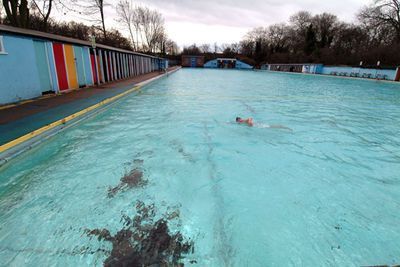Into cleanness leaping
by Adrian Tahourdin
The London Olympics, as we know all too well, are just over a month away. In common with most people who tried to get tickets I was almost entirely unsuccessful: I have one set of tickets for a fencing session, which will be a new experience. I’m not sure quite what to expect.
I was rather hoping — and expecting — to see some cycling and, more especially, a few swimming heats in Zaha Hadid’s spanking new Aquatics Centre — I even took the precaution of applying for tickets to the early rounds as I assumed they’d be less sought after. No such luck.
But I’ve consoled myself with the thought that swimming is weirdly effective as a televised sport: the drama of the race is all the more intense for being indoors and in the water. Add to that the fantastic camerawork and the rapid turnover of heats and you have quite a spectacle. Can anyone who saw it forget Rebecca Adlington’s spectacular 800 metre powerdrive in the Beijing Olympics of 2008? Or Michael Phelps’s eight golds, including one when, he revealed afterwards, his goggles were letting in water and he couldn’t even see properly. Great things are expected of both again. Ian Thorpe (“Thorpedo”) hasn’t made the Australian team, which is a shame as it would have been fun to see him renew his rivalry with Phelps. Thorpe’s stroke was a thing of beauty, swimming elevated to an art form.
What will be the Olympic legacy (dread phrase) in the aquatic sphere? New Olympic-style 50m pools being built around the country? Hardly likely in the current economic climate. Our leisure centres are fine and quite impressive in a way but . . . . On a trip to Toulouse a few years ago I counted six 50 m pools in the city, including a beautiful outdoor one. Toulouse is only France’s fifth largest city; London can only dream of such riches, although it does boast the magnificent Tooting Bec lido (91 metres — why 91?).

But maybe the British don’t need, or especially appreciate, the regimentation of lanes, lifeguards, no-diving notices etc. Books such as the late Roger Deakin’s wonderfully eccentric Waterlog are eloquent testimony to a native ability to find bathing opportunities in unlikely places — not all of them authorized I’m sure. Deakin is the kind of swimmer who could have found a stagnant pond somehow appealing.
To be ranked alongside Deakin’s swimming memoir is Charles Sprawson’s Haunts of the Black Masseur: The swimmer as hero, a rich literary and cultural history of the aquatic sport. Byron, an early conqueror of the Hellespont (a feat in which he has been followed by Sprawson himself) is given due prominence, along with other reckless and brave swimmers such as Byron’s friend Edward John Trelawny, and of course Swinburne. Sprawson reminds us of Goethe’s love affair with water. Did this help to spark a German passion for aquatic sports?
The American broadcast journalist Lynn Sherr has just produced a breezy and informative book, Swim: Why we love the water. Sherr is another successful Hellespont swimmer, a feat she describes in triumphant detail. John Cheever’s “The Swimmer” (“The day was beautiful and it seemed to him that a long swim might enlarge and celebrate its beauty”) gets a section; Sherr reminds us that Burt Lancaster needed swimming lessons in order to perform the title role in the film. Presumably he couldn’t swim when From Here to Eternity was filmed some 15 years earlier.
Among swimming US Presidents, Sherr tells us that Theodore Roosevelt “skinny-dipped in the Potomac” while the athletic Gerald Ford “commissioned the outdoor pool at the White House”. Reagan had been a lifeguard. “In 1933, a White House laundry room was converted into a swimming pool so that the polio-stricken president Franklin Delano Roosevelt could get some exercise. President John F. Kennedy used it for noontime naked swims, partly to relieve his chronic back problems. In 1969, it was bricked over by President Richard Nixon (once photographed walking the beach in shoes and socks) to make, ironically, a press room.“
Sherr’s enthusiasm is infectious, even if she does seem to think Coleridge helped to launch the Romantic movement in 1886. In her bibliography she lists an intriguing-sounding publication, Traité complet de natation: Essai sur son application à l’art de la guerre (1835), by M le vicomte de Courtivron. I must track that one down.
Another book that shouldn't be overlooked is Kate Rew's handsome Wild Swim: River, lake, lido and sea: the best places to swim outdoors in Britain. Usefully divided up by county and full of wonderful photographs, it should be on every amateur swimmer’s shelf. Apart from anything else, it was a singularly magnanimous gesture on the author’s part to reveal so many hitherto unknown spots for swimming. I take guilty (and rather selfish) pleasure from the fact that my own favourite swimming place is absent from the book.
Peter Stothard's Blog
- Peter Stothard's profile
- 30 followers



